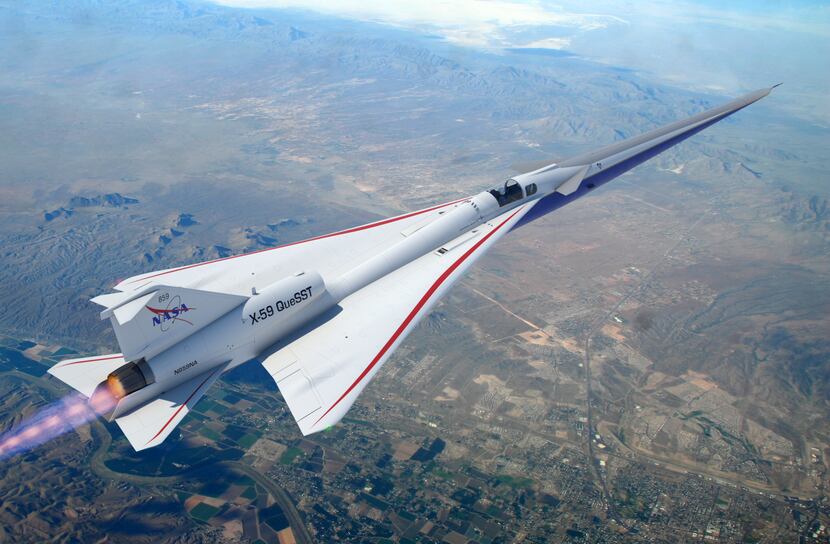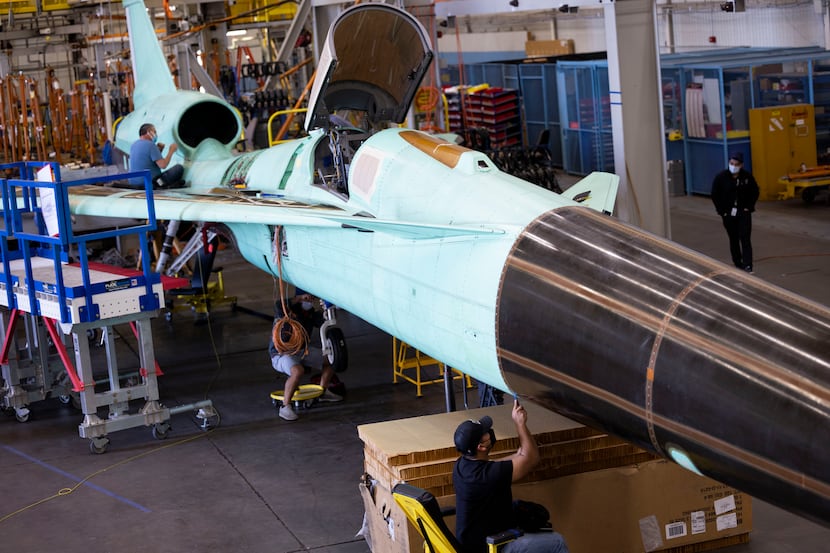NASA developers say the experimental ‘quiet’ supersonic jet aimed at bringing faster-than-sound speeds back to commercial air travel should be ready to fly later this year after stress and technical testing at Lockheed Martin’s Fort Worth factory.
Engineers in are finished with three months of experiments on the 100-foot-long, one-of-a-kind plane called the X-59 QueSST that the U.S. government and the defense manufacturing giant have been developing to quiet the supersonic boom that limited the speed of commercial aviation to the 761 miles per hour sound barrier because of noise complaints.
It also sets the stage for a future of air travel that is two to four times faster than it is today.
The X-59 plane is designed to significantly reduce the sonic boom into a quiet rumble that’s only as loud as a “distant car door slamming” and eliminate the prohibition of flying at supersonic speeds over land. International law prohibits supersonic commercial jets over land because of the startling boom that breaking the sound barrier creates.
NASA and Lockheed Martin are aiming at the commercial aviation sector for the plane, skipping over the military, which has its own supersonic technology, and concerns with the boom created by breaking through the barrier.
The flagship supersonic jet, the Concorde, hasn’t flown since 2003 and even at that point the smaller plane could only carry about 125 passengers. The Concorde was also far more expensive than competing flights across the Atlantic ocean.
“Right now, there’s a speed limit for commercial service and commercial transports flying across the country and it’s Mach one, you can’t fly faster than the speed of sound,” said Craig Nickol, NASA’s project manager for the low boom flight demonstrator project. “That’s because the sonic booms coming off those planes — just not acceptable.”
Creating a plane with less of a boom could convince aviation regulators to allow the plane to travel over land and in turn, give new life to supersonic travel.

There has been renewed interest in faster-than-sound travel in recent months. United Airlines put in an order for as many as 50 fast jets from Boom Supersonic that could reduce the flight time from New York to London to just 3 1/2 hours, down from just under seven now. United said its supersonic jets would be 75% cheaper than the expensive and luxury-priced Concorde flights between the United States and Europe.
However, most airlines have diverted their attention to other next-generation technologies such as electric aircraft and sustainable aviation fuel.
But perhaps a quieter technology could shift the conversation back to speed.
The $247.5 million X-59 jet has been in development since 2018 at Lockheed’s Skunk Works factory in Palmdale, Calif. The current version is meant to fly, but only for testing the volume-reducing capabilities of the quiet supersonic program.
Lockheed Martin engineer Scott Zink said the plane takes many of the unique design elements from past supersonic jets such as the Concorde, including a very long nose cone.
The entire point of the design is to stretch out the supersonic boom over a longer surface and deflect any sound that is made upwards. That would also stretch the sound waves hitting people on the ground, lessening and lengthening the volume.

A flatter belly of the jets makes sure that the sonic boom produced doesn’t travel downward toward the ground and the engine is placed on the top side of the tail so the boom from hitting the large cowls and nacelles deflect upward into the atmosphere.
The old Concorde jets produced a sound level of about 105 decibels, while NASA is aiming for about 75 decibels with the X-59. NASA’s teams are likening the sound of the X-59 more to a “gentle thump” than the startling boom of the Concorde.
This version is designed to travel at about 940 miles per hour, the threshold NASA plans to use for testing, but designers say the concept can be used for bigger and even much faster planes up to three or four times the speed of sound.
The X-59 was shipped to Fort Worth in December where Lockheed Martin teams could test things such as the accuracy of fuel gauges and how much the wings would flex during flight. In the coming weeks, the plane’s nose cone will be taken off and the plane will be put on a semi-truck to be transported back to California.
It also has no front windshield, only a camera that will display the front view on a video screen in order to cut down on the drag created by a window.
The plane should be ready for community sound tests by 2024, giving NASA a reality check on whether the supersonic boom is quiet enough for the public to tolerate, said NASA deputy project manager Cathy Bahm.
NASA and Lockheed don’t have any plans to manufacture the jets, Nickol said.
Once the concept is proven and aviation regulators can be convinced to alter rules for supersonic jets, the technology could be turned over to commercial aircraft manufacturers and airlines to adopt the technology and scale it up for a bigger plane that could carry 100 or more people.
“The Concorde was very popular, but ultimately wasn’t really economical because it was only over the ocean,” Nickol said. “We think if you can fly supersonic over land, it really helps the business cases and opens up all those markets such as flying across the country from New York to Los Angeles.”

